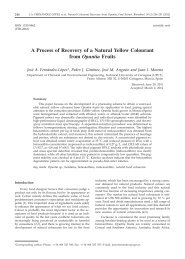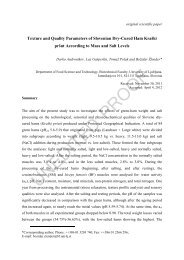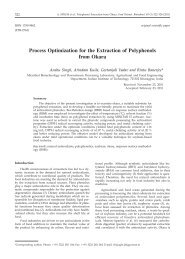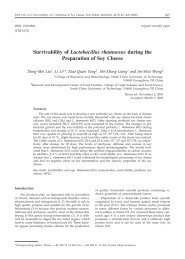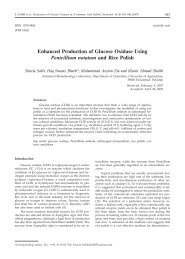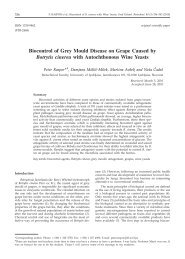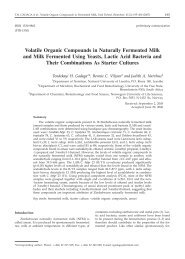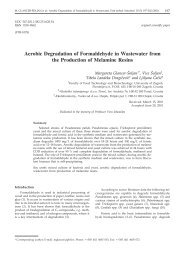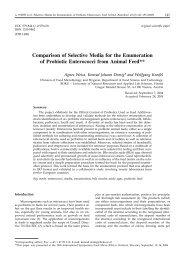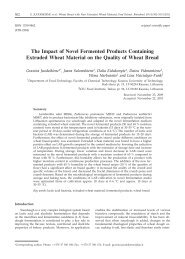200 D. [KEVIN et al.: <strong>Soybean</strong> <strong>Oil</strong> <strong>Bleaching</strong> <strong>Parameters</strong>, Food Technol. Biotechnol. 50 (2) 199–207 (2012)loss <strong>of</strong> oxidative stability can occur, trans fatty acids can<strong>for</strong>m, and free fatty acid (FFA) content may increase(5–9). <strong>Optimization</strong> <strong>of</strong> bleaching parameters, mainly temperature,time, and clay content, is necessary in order tominimize these undesirable oil changes.If only the adsorbent properties <strong>of</strong> clay were important<strong>for</strong> bleaching, the most effective bleaching would occurat lower temperatures since at higher temperaturesthe adsorption equilibrium moves towards desorptionand some <strong>of</strong> the adsorbed molecules dissolve back intothe oil. However, decolouration is better at higher temperatures,which indicates that clay is much more thanan adsorbent. Indeed, chemical reactions take place onthe surface <strong>of</strong> the clay, and the kinetic constants <strong>of</strong> thesereactions, both desirable and undesirable, increase 2- to4-fold with a temperature increase <strong>of</strong> 10 °C (10). There<strong>for</strong>e,there must be an optimum temperature <strong>for</strong> bleaching,and this optimum likely depends on the type <strong>of</strong> oiland levels <strong>of</strong> colour bodies, oxidation products and contaminantspresent. Most types <strong>of</strong> oil are treated in thetemperature range <strong>of</strong> 90–100 °C (11), although bleachingmay be carried out at up to 120 °C if problems are expecteddue to oil specificities (4).The optimal bleaching time depends on the bleachingtemperature and clay quality. Colour removal increaseswith time and temperature, although longer contact<strong>of</strong> oil and clay can cause colour reversion, whichalso increases with temperature. <strong>Bleaching</strong> <strong>for</strong> a longtime at high temperatures seriously damages the oxidativestability <strong>of</strong> edible oil. <strong>Bleaching</strong> time <strong>for</strong> most types<strong>of</strong> oil is in the range <strong>of</strong> 20–30 min at 90–100 °C (4,12,13).High clay content enhances the removal <strong>of</strong> undesirablesubstances in the oil. However, the minimum clayneeded <strong>for</strong> effective bleaching is difficult to establish becausedifferent types <strong>of</strong> oil contain different amounts <strong>of</strong>substances and react differently with clay. Optimal claycontent depends on the type <strong>of</strong> clay, oil pretreatments,and desired quality <strong>of</strong> the oil. It varies between 0.1 and2.0%(14), but it can be as high as 5%inspecial cases (4).These considerations make clear that bleaching parameters,i.e. temperature, duration and clay content, shouldbe determined individually <strong>for</strong> each neutralized oil usingdifferent types <strong>of</strong> bleaching clay. The aim <strong>of</strong> this study isto optimize these bleaching conditions <strong>for</strong> neutralized soybeanoil with Pure-Flo ® Supreme Pro-Active bleachingclay on the laboratory scale, since optimal conditionshave not yet been reported <strong>for</strong> this type <strong>of</strong> vegetable oilbleached with this clay. The effect <strong>of</strong> these parameterson bleaching efficiency, oxidative stability and content <strong>of</strong>bioactive compounds (tocopherols and sterols) has beeninvestigated.Materials and MethodsStandards and chemicalsAll the standards used in this study were <strong>of</strong> HPLCgrade. The following compounds were obtained fromSigma-Aldrich (St. Louis, MO, USA): b-sitosterol (17-[5--ethyl-6-methyl-heptan-2-yl]-10,13-dimethyl-2,3,4,7,8,9,11,12,14,15,16,17-dodecahydro-1H-cyclopenta[a]phenanthren--3-ol), campesterol (17-[5,6-dimethylheptan-2-yl]-10,13--dimethyl-2,3,4,7,8,9,11,12,14,15,16,17-dodecahydro-1Hcyclopenta[a]phenanthren-3-ol),a-cholestanol (10,13-dimethyl-17-[6-methylheptan-2-yl]-2,3,4,5,6,7,8,9,11,12,14,15,16,17-tetradecahydro-1H-cyclopenta[a]phenanthren-3-ol), and stigmasterol (17-[5-ethyl-6-methyl-hept-3-en-2 --yl]-10,13-dimethyl-2,3,4,7,8,9,11,12,14,15,16,17-dodecahydro-1H-cyclopenta[a]phenanthren-3-ol).The compoundsa-tocopherol (2,5,7,8-tetramethyl-2-[4,8,12-trimethyltridecyl]-3,4-dihydrochromen-6-ol)and g–tocopherol (2,7,8--trimethyl-2-[4,8,12-trimethyltridecyl]-3,4-dihydrochromen-6-ol) were obtained from Merck (Darmstadt, Germany).All other chemicals were <strong>of</strong> suitable purity grade.MaterialsIndustrially neutralized soybean oil (Zvijezda d.d.,Zagreb, Croatia) was bleached using Pure-Flo ® SupremePro-Active bleaching clay (<strong>Oil</strong>-Dri Corporation <strong>of</strong> America,Chicago, IL, USA). This is an adsorbent manufacturedusing a proprietary surface modification technology (SMT).Raw material <strong>of</strong> the adsorbent is an intergrowth <strong>of</strong> hormiteand smectite minerals. SMT processing, combinedwith the intrinsic qualities <strong>of</strong> the mineral, produces ahighly active, fast-filtering product that removes coloursfrom corn, canola and soybean oil, in addition to removingsoaps, phospholipids and metals such as Ca, Fe,Mg and Ni. Manufacturer specifications <strong>of</strong> the bleachingclay (<strong>Oil</strong>-Dri Corporation <strong>of</strong> America) indicate a freemoisture content <strong>of</strong> 14–18 % at 105 °C and pH=2.4 to 3.3(5 % solids in deionized H 2 O).<strong>Bleaching</strong> <strong>of</strong> oil under laboratory conditionsLaboratory bleaching was per<strong>for</strong>med in a round--bottom, three-necked flask <strong>of</strong> 500 mL equipped with athermometer and attached to a vacuum pump and nitrogensource (Fisherbrand bleaching equipment, Fisherscientific Ltd, Loughborough, UK and Gast 0211 vacuumpump, Gast, Benton Harbor, MI, USA). <strong>Bleaching</strong> wasconducted using an electromagnetic mixer with adjustableheater. All bleaching parameters are given in Table1. Briefly, 200 g <strong>of</strong> industrially neutralized soybean oilwas weighed into a round-bottom, three-necked flaskTable 1. <strong>Bleaching</strong> parameters <strong>of</strong> soybean oil samplesSamplew(clay)%<strong>Bleaching</strong> parametersTimeminTemperature°C120 1052950.5303 1154 40 105595206 1157 130 105895409 1151020 10511951.53012 11513 40 105
D. [KEVIN et al.: <strong>Soybean</strong> <strong>Oil</strong> <strong>Bleaching</strong> <strong>Parameters</strong>, Food Technol. Biotechnol. 50 (2) 199–207 (2012)201and heated with mixing under a partial vacuum <strong>of</strong> 0.4bar. <strong>Bleaching</strong> clay was added to a final concentration <strong>of</strong>0.5, 1.0 or 1.5 % to the oil preheated to approx. 60 °C.The oil was then gradually heated to the desired bleachingtemperature (95, 105 or 115 °C) with constant mixingunder vacuum to disperse the clay completely. Afterreaching the desired temperature, the heating was temporarilyturned <strong>of</strong>f to allow the temperature to fall byapprox. 2–3 °C. Then the heating was turned on againand kept constant <strong>for</strong> the desired bleaching time (20, 30or 40 min). At the end <strong>of</strong> bleaching, heating and vacuumwere turned <strong>of</strong>f and nitrogen supply was turned on.After bleaching, hot sludge from the flask was filteredthrough filter paper (Whatman no. 541) under vacuum.Samples <strong>of</strong> bleached oil were stored at –18 °C untilfurther analysis.Analytical methodLovibond colour was determined according to theISO method (15) using Lovibond Colourscan (TintometerLtd., Amesbury, UK). Transparency was measured at 455nm on a Cary 100 Scan spectrophotometer (Varian, PaloAlto, CA, USA) following the method <strong>of</strong> O{tri}-Matija-{evi} et al. (16). Transparency <strong>of</strong> samples was measuredin undiluted oil using distilled water as a blank.The elements P, Fe and Cu in oil were determinedusing an inductively coupled plasma atomic emissionspectroscopy (ICP-AES) method (17,18) on a Vista-MPX(Varian). The three elements were analyzed by directinjection <strong>of</strong> a sample dissolved in PremiSolv ICP solvent(SCP Science, Conostan, Montreal, Quebec, Canada). Determination<strong>of</strong> the peroxide value (PV) was carried outfollowing ISO 3960:2007 analytical method (19) and theanisidine value following ISO 6885:2006 method (20).These two values were used to calculate the Totox (totaloxidation) value using <strong>for</strong>mulae from O{tri}-Matija{evi}and Turkulov (21). Specific UV absorption at 232 and 270nm (K 232 and K 270 , respectively) was measured followingISO 3656:2011 method (22). Free fatty acid (FFA) contentwas determined using ISO 660:2009 method (23).Sterol content and composition were determinedusing gas chromatography and ISO 12228:1999 method(24). The prepared sterol fraction (1 µL) was injectedinto a gas chromatograph (series 610, ATI Unicam, Cambridge,UK) equipped with a DB-17 capillary column (30m×0.32 mm×0.25 mm) containing 50 % phenyl-methylpolysiloxanestationary phase. Helium was used as carriergas at a flow rate <strong>of</strong> 0.36 mL/min. The temperature<strong>of</strong> the injector was set to 280 °C and the temperature <strong>of</strong>the detector to 290 °C. The temperature <strong>of</strong> the columnoven was programmed to increase at 6 °C/min from aninitial value <strong>of</strong> 180 to 270 °C, and then to remain at thisvalue <strong>for</strong> 30 min. Peaks were identified by comparingthe retention times <strong>of</strong> sterols with those <strong>of</strong> the standards.Quantification <strong>of</strong> all sterols was based on an internal standardmethod using a-cholestanol.Tocopherol content and composition were determinedusing a standard ISO method (25). Analysis wasper<strong>for</strong>med by high-per<strong>for</strong>mance liquid chromatography(HPLC) using a ProStar 363 (Varian) equipped with aProStar fluorescent detector and a Restek Pinnacle II silicacolumn (15 cm×4.6 mm, 5 µm). Sample was preparedby dissolving 0.1 g <strong>of</strong> soybean oil in 10 mL <strong>of</strong> n-hexane,and 20 µL <strong>of</strong> the solution was injected in the column.Detection <strong>of</strong> tocopherols was per<strong>for</strong>med at an excitationwavelength <strong>of</strong> 295 nm and emission wavelength <strong>of</strong> 330nm. Isocratic chromatography at room temperature wasused with a mobile phase <strong>of</strong> 0.7 % propan-2-ol in n-hexaneat a flow rate <strong>of</strong> 0.6 mL/min. Quantification <strong>of</strong> tocopherolswas per<strong>for</strong>med using standard calibration curves<strong>of</strong> a- and g-tocopherol covering the mass fraction range<strong>of</strong> 5–750 mg/kg.Statistical analysesA Box-Behnken design <strong>for</strong> three factors was used todesign the samples (26). The Friedman-type statistics <strong>for</strong>ranking the data was calculated to rank the samples accordingto bleaching efficiency and oxidative stability.Nonparametric analogues to Fisher’s least significantdifferences (LSD) <strong>for</strong> ranking the sums were calculated,and a multiple comparison procedure was per<strong>for</strong>med todetermine the significance <strong>of</strong> differences between thebleaching efficiency and oxidative deterioration parametersevaluated by the ranking test (27). Principal componentanalysis (PCA) was per<strong>for</strong>med to reduce thenumber <strong>of</strong> correlated variables, and to determine whichparameters significantly affected bleaching outcomes. Allstatistical analyses were per<strong>for</strong>med using the s<strong>of</strong>twarepackage STATISTICA v. 9 (28).Results and Discussion<strong>Bleaching</strong> was per<strong>for</strong>med on industrial neutralizedsoybean oil in the laboratory under vacuum and nitrogenatmosphere, using Pure-Flo ® Supreme Pro-Activebleaching adsorbent. The values <strong>for</strong> temperature, duration<strong>of</strong> bleaching and clay content tested in this studywere based on the literature (2,4,5,29) and on previousexperience with bleaching at the refining plant <strong>of</strong> theZvijezda oil factory, Zagreb, Croatia. Three bleachingtemperatures (95, 105 and 115 °C), three clay amounts(0.5, 1 and 1.5 %) and three bleaching durations (20, 30and 40 min) were tested. A Box-Behnken design <strong>for</strong>three factors was used to design the samples. The designconsisted <strong>of</strong> 12 different cases, with the 13th centralcase representing an average valuation <strong>of</strong> variables (Table1). All reported results are mean values <strong>of</strong> duplicate analyticaldeterminations.<strong>Bleaching</strong> efficiency was monitored by measuring thereduction in colour bodies, metal contaminants and oilretention by the bleaching clay. Colour bodies <strong>of</strong> oils andfats are pigments, primarily chlorophylls and carotenoids.<strong>Soybean</strong> oil contains small amounts <strong>of</strong> chlorophylls,and the main carotenoids are xanthophylls. Reduction <strong>of</strong>colour bodies in this work was measured according tothe Lovibond method (Table 2). The greatest reductionin red (72 %) and yellow units (26 %) in neutralized oilwas achieved using the highest clay content (1.5 %) atthe highest temperature (115 °C) during 30 min. Substantialremoval <strong>of</strong> colour substances makes the oil highlytransparent. The highest transparency, 12-fold greater thanthat <strong>of</strong> neutralized oil, was obtained with the highest claycontent, at higher temperature (105 and 115 °C) andthrough all time durations.




